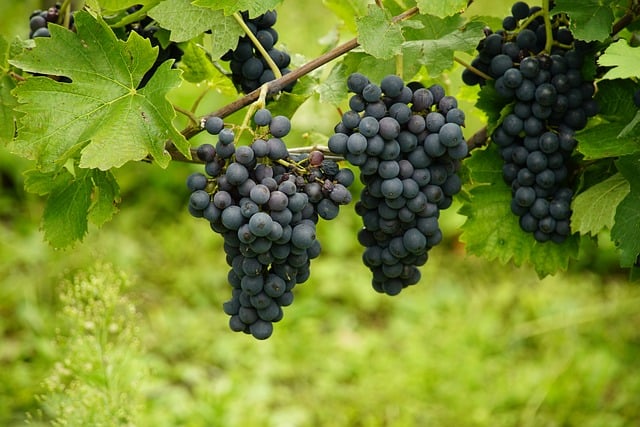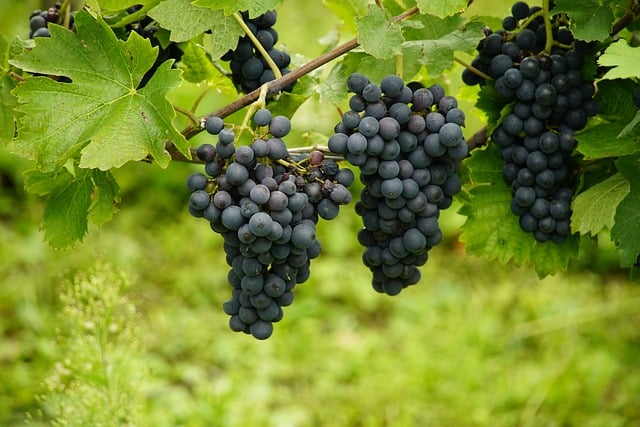
Granny grapes ('Vitis labrusca'), known for their sweet flavor, thick skin, and adaptability, are a versatile fruit suitable for culinary and winemaking. They're self-fertile, pest-resistant, and offer a range of flavors from muscat to Concord, ideal for producing distinctive wines. Their high sugar content ensures intense sweetness, whether consumed fresh or used in recipes. For the best flavor, choose fully ripened fruits, which can be identified by color changes and skin softening. Granny grapes, also known as 'Thompson Seedless' and with a history tracing back to ancient civilizations, are California's official state grape, celebrated for their sweetness and lack of seeds. They've been cultivated worldwide due to their hardiness and prolific nature. Advances in viticulture have led to consistent high-quality productions while maintaining the varietal's signature flavor. Clonal selections tailored to different climates and soils ensure their continued popularity.
In terms of appearance, Granny grapes are round and about one to two inches in size, with a golden yellow skin that turns green at the stem, indicating ripeness. They have a sweet, musky taste with nuanced flavors like pineapple, melon, citrus, and a hint of nuttiness. Their juicy texture and tender skin make them a delightful addition to dishes or a simple pleasure when eaten fresh. Cultivation requires full sun, well-drained fertile soil with a pH between 5.5 and 6.5, proper spacing for airflow and sunlight, regular watering with mulching to conserve moisture, pruning in early spring, training on trellises for improved grape quality, and vigilant monitoring for pests and diseases like powdery mildew and grape berry moth. With the right care, home gardeners can enjoy their own Granny grape harvest.
Discover the rich world of Granny grapes, a fruit variety renowned for its plump, sweet-tart flavor and vibrant color. This comprehensive article delves into the origins, growth characteristics, and myriad benefits of incorporating these versatile berries into your lifestyle. From understanding how to cultivate your own healthy vines to exploring the global appeal of Granny grapes in culinary and beverage applications, this guide offers valuable insights for enthusiasts and experts alike. Join us as we navigate through the health advantages, innovative farming techniques, and creative recipes that make Granny grapes a standout fruit.
- Understanding Granny Grapes: A Comprehensive Guide
- The History and Origins of Granny Grapes
- Characteristics of Granny Grapes: Size, Color, and Flavor Profiles
- Cultivation and Care: Tips for Growing Your Own Granny Grapes
Understanding Granny Grapes: A Comprehensive Guide

Granny grapes, known botanically as ‘Vitis labrusca’, are a distinct variety of grape that have been cultivated for their fruit, which is often used for jams, jellies, and wines. These round to oval-shaped berries boast a thick skin relative to other table grapes, enclosing a sweet, richly flavored pulp. The skin’s robust nature contributes to the grape’s resilience, making it a hardy choice for growers in various climates. When ripe, Granny grapes exhibit a spectrum of colors ranging from greenish-yellow to deep purples and can be identified by their characteristic ‘droopy’ appearance, which is due to their heavy yield. The fruit’s high sugar content gives rise to its intense sweetness and a variety of aromatic profiles, including muscat and Concord grape notes. For those interested in cultivating these grapes, they should note that Granny grapes are self-fertile, which simplifies the process of pollination and fruit production. Additionally, they are relatively pest-resistant, making them a favorable choice for both commercial growers and home gardeners looking to expand their vineyard or backyard produce.
In terms of culinary applications, Granny grapes are incredibly versatile. Their intense sweetness allows them to stand alone as a fresh fruit snack or to be the star ingredient in a wide array of recipes. The thick skin also means that after being picked, they can be preserved through drying or fermentation without losing their flavor. Winemakers appreciate Granny grapes for their ability to produce unique wines with distinct flavors ranging from fruity and floral to earthy and spicy, depending on the varietal used in blending. When selecting Granny grapes for consumption or processing, it’s crucial to choose fruits that are fully ripened, as this will ensure the highest sugar content and the most intense flavor. Growers can optimize their harvests by monitoring the ripeness indicators, such as color change and softening of the skin, to determine the ideal time for picking. Whether for immediate enjoyment or long-term preservation, Granny grapes offer a world of possibilities for those who appreciate the sweet and flavorful experiences they provide.
The History and Origins of Granny Grapes

Granny grapes, also known as ‘Thompson Seedless,’ are a variety that trace their origins back to ancient times, with roots believed to be in the Middle East or Asia. Over the centuries, they have been propagated and cultivated across various regions due to their exceptional taste and versatility. The grape’s history is intertwined with human civilization, as it has been a staple in wine production, table use, and even raisin making for millennia. The grape’s resilience to hot climates and its ability to produce a consistent crop made it a favored varietal among growers in regions like California, where it was officially named the state grape in 1984. Today, Granny grapes are celebrated for their sweetness and seedless feature, making them a popular choice for consumers worldwide.
In the quest for high-quality fruit, the cultivation of Granny grapes has seen significant advancements in viticulture practices. These advancements have not only improved yield but also ensured that the varietal maintains its signature taste profile, which is characterized by its intense sweetness and subtle muscat flavor. The global proliferation of Granny grapes has led to various clonal selections, each adapted to different climates and soil types, further cementing their place in the annals of viticultural history. As a result, Granny grapes continue to be a beloved fruit, not only for their historical significance but also for their exceptional culinary applications and the simple pleasure they provide as a table grape.
Characteristics of Granny Grapes: Size, Color, and Flavor Profiles

Granny grapes, a delightful variety of table grapes, are renowned for their distinctive characteristics that set them apart from other grape cultivars. These grapes typically exhibit a plump and spherical shape, with an average size that can range from one to two inches in diameter, making them particularly easy to identify and select. Their skin is characterized by a vibrant golden hue that often has a blush of green at the stem end, adding a touch of elegance to their appearance. The color of Granny grapes is not only visually appealing but also indicative of their ripeness.
When it comes to flavor profiles, Granny grapes are prized for their sweet and musky taste that offers a unique contrast to more common green or red table grapes. They possess a rich and complex flavor with subtle notes of pineapple, melon, and citrus, which is complemented by a hint of nuttiness. This blend of flavors makes them a versatile addition to both sweet and savory dishes, as well as an excellent choice for enjoyment straight from the vine. The texture of Granny grapes is another highlight; they are juicy with a tender skin that yields readily to the teeth, releasing their succulent juices that are both refreshing and satisfying. Their one-of-a-kind flavor and exceptional eating quality make Granny grapes a sought-after fruit in various culinary settings.
Cultivation and Care: Tips for Growing Your Own Granny Grapes

Granny grapes, also known as ‘Lenoir’ or ‘Scuppernong,’ are a popular variety for those interested in cultivating their own grape vines due to their large, sweet fruit and rich flavor. Successful cultivation of Granny grapes begins with selecting a suitable location—a spot that receives ample sunlight, approximately 6 to 8 hours daily. The soil should be well-drained, fertile, and ideally has a pH between 5.5 and 6.5. To plant, space vines 8 to 10 feet apart within rows spaced 10 to 12 feet apart to allow for adequate air circulation and sunlight penetration.
Consistent care is essential for the health and productivity of your Granny grape vines. Watering is critical; provide deep, regular watering during the growing season to maintain soil moisture without saturating the soil. Mulching helps retain soil moisture and suppress weeds. Pruning is a vital practice that encourages fruit production and vine health. Remove any dead, diseased, or competing wood in early spring before new growth begins. Additionally, training the vines to grow on a trellis or support system can enhance grape quality and make harvesting easier. Regular monitoring for pests and diseases, along with applying appropriate treatments when necessary, will protect your Granny grapes from common threats such as powdery mildew and grape berry moth. With the right conditions and care, you can enjoy the sweet rewards of your homegrown Granny grapes.
Granny grapes, a delightful variety rich in history and unique characteristics, have captivated enthusiasts and home gardeners alike. From their origins to their cultivation, this comprehensive guide has illuminated the path for anyone interested in understanding and growing these flavorful fruits. Whether you’re a seasoned grower or a novice gardener, the insights provided here ensure that your granny grapes will thrive, offering sweet rewards. As a final note, remember that patience and care are key when tending to these vines; the awaited harvest of juicy, purple clusters is well worth the wait. Happy growing!





